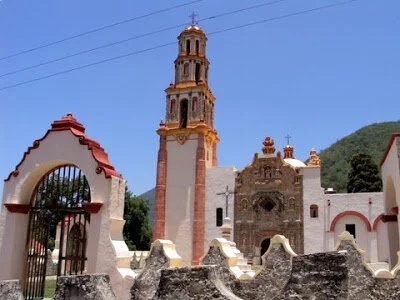BEST ROADS TRAVELED: Junípero Serra’s Missions of the Sierra Gorda
“Oh, the bear went over the mountain . . . to see what he could see,” goes a campfire song of my girlhood, sung to the tune of “For He’s a Jolly Good Fellow.”
And I’ve been checking out the other side of mountains both real and imagined all my life. Always, an adventure awaits!
When I was living in San Miguel de Allende, Mexico, I joined Morton Stith, PhD, friend and art historian, and a small group of other intrepid travelers on a journey into the Sierra Gorda, an ecological region located in the northern third of Querétaro and extending into the neighboring states of Guanajuato, Hidalgo, and San Luis Potosí.
It’s rugged territory consisting of high, steep mountains and deep canyons and contains a wide diversity of plant and animal life due to its various microenvironments. During the 160-mile bus trip, we would pass through Bernal, Vizarron de Montes, and Pinal de Amoles at almost 8,000 feet, then drop down to Jalpan de Serra at 2,400 feet where we would spend the night and visit four of the five remarkable missions conceived by Fray Junípero Serra and constructed by native peoples in the mid-18th century.
Many know Junípero Serra’s California missions, the first nine of twenty-one missions built by the Catholic Church from San Diego to San Francisco. I visited many of them throughout my years there. But I was astounded at the design differences between Jalpan’s richly imaginative missions and those that came later in the north.
Back in about 1744, Fray Serra was dispatched from Mexico City to Jalpan to set up missions for the conversion of the nomadic Pame people. It took him and the ten friars accompanying him sixteen days to make the trip and he would remain in the region for an estimated 20 years before moving north to California.*
Jalpan is home to the first and largest of Serra’s five missions—Misión de Santiago de Jalpan—with the others located at the villages of Landa de Matamoros, Tancoyal, Tilaco, and Concá. Stunning photographs by John Barreiro illustrate each mission’s unique beauty, with many close-ups showing interior and exterior details.
These five missions, hidden away in a region seldom visited by most travelers to Mexico, have been named a UNESCO World Heritage site. They are among the best examples in existence of how, in spite of Serra’s insistent efforts to convert the local people to Christianity, the local craftsmen subverted saints, angels, cherubs, mermaids, eagles, serpents, plants and other design elements into an assemblage of their own gods and goddesses. Oppressed people always find a way. There has been some restoration of the façades in more modern times, but I’ve read that it has been carefully done and it is still possible to see and imagine the original glory of these edifices.
For me, like the bear in the song, I went to see what I could see and I was thrilled. It was if I had stepped into another world. We often take for granted the art and craftsmanship surrounding us, available every day, but sights such as these remind us that modern life does not have a franchise on creativity—the search for beauty and meaning is present throughout human history. And you never know what you might discover when you take off for parts unknown!
*Dates are all estimates as accounts and sources vary.





